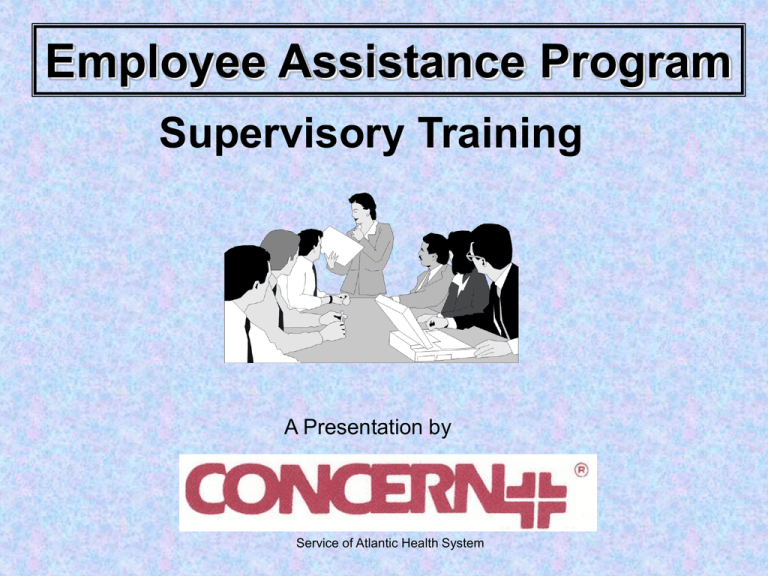Employee Assistance Program Supervisory Training A Presentation by Service of Atlantic Health System
advertisement

Employee Assistance Program Supervisory Training A Presentation by Service of Atlantic Health System GOAL OF TRAINING • To understand the Employee Assistance Program as a resource to employees and family members • To learn to recognize signs of troubled employees • To understand how to initiate “supervisory referrals” • Two levels – as an employee – as a supervisor SUPERVISOR TRAINING Outline • Employee Assistance Program – What is it? – Historical perspective – How Does it work? – Types of referrals • Recognizing Troubled Employees • Initiating Supervisory Referrals • Wrap Up – Questions/Discussion EMPLOYEE ASSISTANCE PROGRAM (EAP) What Is It? A company benefit that gives employees and their family members access to nocost assessment and referral services. EAP - HISTORICAL PERSPECTIVE • Originated in 1950s – labor and management – focus – alcohol only • Evolved – Broad Brush Programs • Goal – get help for troubled employees and their family members. EAP AS A BENEFIT • Contract – covers all eligible faculty/employees and their household members – 1 to 3 sessions – no charge to employees or household family – confidential – flexible appointments WHEN TO USE THE EAP • stress • relationship issues • communication difficulty • depression • marital conflicts • alcohol and drug problems • • • • • • • work place conflict emotional difficulties gambling problems loss/grief financial concerns parenting issues anxiety Any time an issue exists! CONFIDENTIALITY • Cornerstone to success of EAP • State and Federal Laws – govern EAP – CFR 42 Part 2 • Information released – only with signed release – “informed consent” EAP REFERRALS • Self Referrals employee/family member initiates EAP services • Independently or at suggestion of family member, friends, co-worker • Supervisory Referral – employee referred to EAP services by supervisor/manager • Formal or Informal SUPERVISOR/MANAGER ROLE Rights: To expect good job performance Responsibilities: • Safe work environment • Make sure job gets done • Ensure quality in the product/service To do this, manager must: • Know what it takes to get job done • Know employees’ abilities • Know if change in either • Communicate job expectations MANAGING TROUBLED EMPLOYEES • Recognize • Observe • Document • Feedback • Resolution RECOGNITION • • • • • • Pattern of Unacceptable Behavior Frequent Work Related Injuries Attendance Issues Errors or poor Judgment Inconsistent/Low Productivity Attitude OBSERVATION • Observe job performance in greater detail • Focus on observable, measurable, verifiable facts • Do not diagnose • Use behavioral observation of poor job performance list Expectation: Jack will report to work at 8:30AM Observation: 3 out of 5 workdays Jack has reported to work after 8:30AM – 1 day, after 10:00AM Expectation: Jack will meet all scheduled deadlines Observation: In the last 30 days, Jack has missed 5 deadlines DOCUMENTATION • Provides accurate picture of job performance • Supports corrective action process • Use job performance log State: 1. Date 2. Type of incident 3. Significant behaviors observed 4. Significance/consequences to workplace – positive & negative ACTION Before meeting with employee: – Consult with HR / EAP regarding procedural and disciplinary measures – Complete documentation – Review significant job performance log – Arrange meeting with employee FEEDBACK During the feedback session: • • • • • • • • • Quiet, private room with a door Speak to employee directly Assure confidentiality Focus on behaviors you have observed and documented Do not agree to keep secrets Define problems created for workplace Discuss the EAP Develop performance expectations and criteria for measuring success Schedule time for follow-up meeting RESOLUTION Manager’s Role: • Provide clear definition of expectations • Direct employee to appropriate resources (EAP) • State clearly the consequences if employee does not meet expectations • Continue regular supervision Employee’s Role: • Recognize problem as stated • Make use of resources to solve the problems GENERAL DO’s AND DON’Ts • Do’s – Follow company policies and procedures – – – – Be clear about performance issues Explain what the EAP is and how it works Emphasize confidentiality Be clear about expectations,consequences, time frames • Don’ts – Delay confrontation and referral – – – – – Label or diagnose problem Cover up the problem Succumb to sympathy-evoking tactics Play counselor Offer personal solutions WRAP UP • Summary • Questions • Discussion CONCERN EAP Services Partners in finding solutions to work, family, and personal matters Just a confidential call away 800-242-7371

